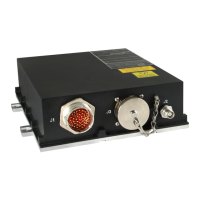INSTALLATION MANUAL
CMA-5024 GLSSU
This document includes Proprietary Information and shall not be reproduced or communicated to third party
without prior written permission by CMC Electronics Inc.
Page 102
Revision 1 Jan 19, 2009
The system integrator will determine the location of each antenna and, if deemed necessary for this aircraft,
compute the X Y Z coordinates of the Navigation Center Offset. These coordinates must match the
Navigation Center Lever Arm APD parameters defined in the APD Configuration to be selected and will be
used to compute the guidance outputs (deviations and distance to runway threshold). Refer to the APD
parameter "Navigation Center Position Output on GLS Bus" in Appendix E for use of the navigation center
on the GLS bus.
Note: The Navigation Center Lever Arm APD parameters are set to zero when the system integrator
determines that the guidance outputs can be computed at the antenna location.
The system integrator will determine if the HIS in the GLSSUs must be connected to the existing ILS/DME
instrumentation, and how. He will determine also if the auxiliary HIS power inputs (at connector pins J3-1
and J3-2) must be connected, so that ILS and DME outputs pass-through unaffected in case of a failure of
the GLSSUs or of their 28 VDC power inputs (at connector pins J1-34, J1-35).
Note: In order to avoid nuisance failure warnings, the same 28 VDC power source should feed both
the GLSSU power input and its HIS. Refer to the HIS Input Power APD parameter in
Appendix E. However, independent power lines and circuit breakers should be used in order
to preserve redundancy.
The system integrator will determine the interfaces and interconnections between the GLSSUs and the flight
instruments. Refer to the typical installation diagrams in Section I.
Note: In order to comply with TSO-C145b/TSO-C146b, the GLSSU must output navigation and/or
flight deviation data at a minimum rate of 5 Hz. This requires configuring by means of the APD
of at least one GLS output bus on the approach aircraft connector J3, which will provide a
nominal data output rate of 10 Hz; typically all 3 busses are configured as GLS outputs.
CAUTION: In a Delta-4 configuration and if connecting DME equipments to a GLSSU, the DME
devices MUST
transmit sequential blocks of data for each DME channel, Frequency label
first, in accordance with paragraph 4.8 of ARINC 709-8 or of paragraphs 4.8.1 and
4.8.1.2.4 of ARINC 709A-1. Refer to the HIS description in section I.
If applicable, the system integrator will ensure that the GLSSU has access to an SBAS approach database
readily available from external equipment, typically from an FMS. Alternately, the built-in database of the
GLSSU can be used. In this case, an ARINC-615 Data Loader bus is available for loading and updating
periodically the built-in database; refer to the instructions and to the Data Loading procedure in Appendix F.
Based on the aircraft, antenna and installation characteristics, the system integrator will choose the
applicable APD File. At time of installation, the installer will select the applicable APD Configuration and will
verify its proper selection as described in Section III. Refer to Section I for a general description of the APD
concept, and to Appendix E for the description of the APD parameters and APD Configuration within
currently available APD Files.
The GLSSU being a sensor, its operation is intended to be fully automatic with the exception of approach
selection. Flight crews do not have physical access to the GLSSU and cannot control it directly. Thus,
typically, the system integrator will design the installation for enabling access to the GLSSU data via the
Control Display Units (CDU) of a Flight Management System (FMS) or via alternate means. The applicable
access procedures and display formats will be found in the aircraft operational flight manual and/or its
supplement.
The document reference is online, please check the correspondence between the online documentation and the printed version.

